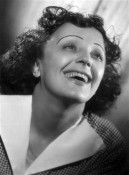Edith Piaf

Édith Piaf (born Edith Giovanna Gassion; Paris, 19 December 1915 – Grasse, 11 October 1963) was a French singer best known for performing songs in the cabaret and modern chanson genres. She is widely regarded as France's greatest popular singer and one of the most celebrated performers of the 20th century.
Submitted by Anonymous at Thursday 27th of December 2012 15:23